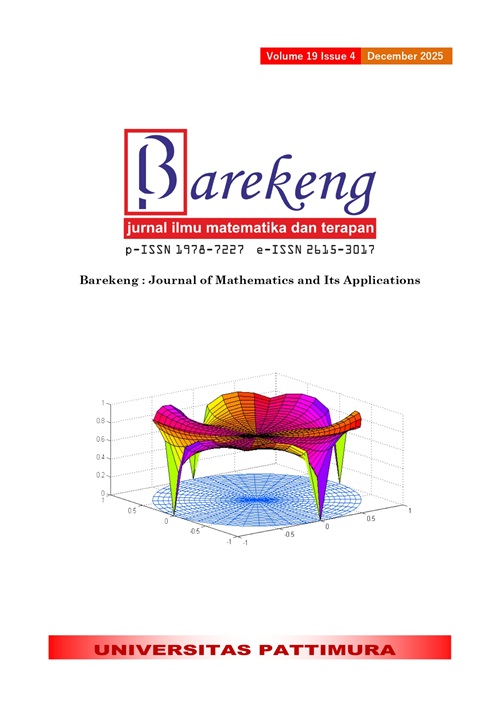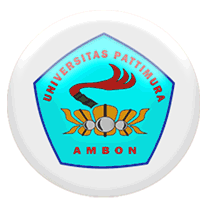TRUNCATED SPLINE SEMIPARAMETRIC REGRESSION TO HANDLE MIXED PATTERN DATA IN MODELING THE RICE PRODUCTION IN EAST JAVA PROVINCE
Abstract
Climate change can affect rice production through changes in temperature, precipitation patterns, extreme weather events, and atmospheric carbon dioxide levels. A statistical model can be used to understand the correlation between rice production and factors that affect it. The existence of some patterns that are formed from independent variables and others that do not show data patterns due to volatility in weather element data makes semiparametric regression modeling more appropriate. In forming a parametric model, the data pattern needs to be regular to make the model more precise. Irregular data patterns are more appropriately modeled with nonparametric regression models. The existence of several patterns formed from independent variables to their dependent variables, and several others, does not show a particular pattern due to the volatility in climate data, making truncated spline semiparametric regression modeling more appropriate to use. This research aims to model rice production in several regions in East Java Province in 2022 using a semiparametric regression model. The data used were from the Meteorology, Climatology, and Geophysics Agency and the Central Statistics Agency for East Java Province in 2022. The response variable is the rice production (tons) in 2022 in Tuban, Gresik, Nganjuk, Malang, Banyuwangi, and Pasuruan Regency (Y). The predictor variables are paddy harvested area (hectares), average temperature (℃), humidity (percent), and rainfall (mm). The semi-parametric spline truncated regression model is obtained by combining the parametric and non-parametric models based on truncated splines. The analysis showed a spline truncated semiparametric regression model with a combination of knot points (3,3,1) with a minimum GCV value of 12,642,272. The variables significantly affecting rice production were rice harvest area, temperature, air humidity, and rainfall, with an adjusted value of 98.522%.
Downloads
References
R. S. Pirngadi and Rahmawaty, “THE IMPACT OF FLOODING ON RICE PRODUCTION IN THE KRUENG KLUET WATERSHED, ACEH PROVINCE, INDONESIA,” IOP Conf. Ser. Earth Environ. Sci., vol. 977, no. 1, 2022, doi: https://doi.org/10.1088/1755-1315/977/1/012113.
J. Cao et al., “INTEGRATING MULTI-SOURCE DATA FOR RICE YIELD PREDICTION ACROSS CHINA USING MACHINE LEARNING AND DEEP LEARNING APPROACHES,” Agric. For. Meteorol., no. 297, pp. 1–15, 2021.doi: https://doi.org/10.1016/j.agrformet.2020.108275
E. Kamir, F. Waldner, and Z. Hochman, “ESTIMATING WHEAT YIELDS IN AUSTRALIA USING CLIMATE RECORDS, SATELLITE IMAGE TIME SERIES AND MACHINE LEARNING METHODS,” J. Photogramm. Remote Sens., no. 160, pp. 124–135, 2020.doi: https://doi.org/10.1016/j.isprsjprs.2019.11.008
P. J. T. Badan Pusat Statistik, “PRODUKSI PADI DAN BERAS MENURUT KABUPATEN/KOTA DI PROVINSI JAWA TIMUR, 2021 DAN 2022,” BPS, 2023. https://jatim.bps.go.id/id/statistics-table/1/MjUyMyMx/-produksi-padi-dan-beras-menurut-kabupaten-kota-di-provinsi-jawa-timur-2021-dan-2022-.html (accessed Mar. 16, 2023).
V. D. Islami, R. Fitriani, and H. Pramoedyo, “SPATIALLY FILTERED RIDGE REGRESSION MODELING TO FIND OUT THE RICE PRODUCTION FACTORS IN EAST JAVA, INDONESIA,” CommIT J., vol. 14, no. 2, pp. 95–102, 2020, doi: https://doi.org/10.21512/commit.v14i2.6665.
D. Darmadi, A. Junaedi, D. Sopandie, Supijatno, I. Lubis, and K. Homma, “WATER-EFFICIENT RICE PERFORMANCES UNDER DROUGHT STRESS CONDITIONS,” AIMS Agric. Food, vol. 6, no. 3, pp. 838–863, 2021, doi: https://doi.org/10.3934/agrfood.2021051.
W. Sanusi, R. Syam, and R. Adawiyah, “MODEL REGRESI NONPARAMETRIK DENGAN PENDEKATAN SPLINE (STUDI KASUS: BERAT BADAN LAHIR RENDAH DI RUMAH SAKIT IBU DAN ANAK SITI FATIMAH MAKASSAR),” J. Mat. dan Komputasi, vol. 2, no. 1, pp. 70–81, 2017.doi: https://doi.org/10.35580/jmathcos.v2i1.12460
M. Kaseside and S. B. Loklomin, “ANALISIS ANGKA KEMATIAN BAYI KABUPATEN HALMAHERA UTARA DENGAN METODE REGRESI NONPARAMETRIK SPLINE TRUNCATED,” J. Stat., vol. 3, no. 1, pp. 1–5, 2021.doi: https://doi.org/10.30598/variancevol3iss1page1-5
M. F. F. Mardianto, S. M. Ulyah, and E. Tjahjono, “PREDICTION OF NATIONAL STRATEGIC COMMODITIES PRODUCTION BASED ON MULTI-RESPONSE NONPARAMETRIC REGRESSION WITH FOURIER SERIES ESTIMATOR,” Int. J. Innov. Creat. Chang., vol. 5, no. 3, pp. 1151–1176, 2019.
A. Tsalasatul Fitriyah, N. Chamidah, and T. Saifudin, “PREDICTION OF PADDY PRODUCTION IN INDONESIA USING SEMIPARAMETRIC TIME SERIES REGRESSION LEAST SQUARE SPLINE ESTIMATOR,” Data Metadata, vol. 4, 2025, doi: https://doi.org/10.56294/dm2025527.
Liu.Y. and L. Shuwey, “A SEMIPARAMETRIC MIXTURE CURE MODEL FOR PARTLY INTERVAL CENCORED FAILURE TIME DATA,” J. Stat. Appl. Probablity, vol. 10 No.1, pp. 1–10, 2021.doi: https://doi.org/10.18576/jsap/100101
E. D. Igustin and I. N. Budiantara, “PEMODELAN FAKTOR-FAKTOR YANG MEMPENGARUHI TOTAL FERTILITY RATE DI INDONESIA MENGGUNAKAN REGRESI NONPARAMETRIK SPLINE TRUNCATED,” J. Sains dan Seni, vol. 9, no. 2, pp. 178–185, 2020.doi: https://doi.org/10.12962/j23373520.v9i2.56791
J. Li, W. Zhang, P. Wang, Q. Li, K. Zhang, and Y. Liu, “NONPARAMETRIC PREDICTION DISTRIBUTION FROM RESOLUTION-WISE REGRESSION WITH HETEROGENEOUS DATA,” J. Bus. Econ. Stat., vol. 41, no. 4, pp. 1157–1172, Oct. 2023, doi: 1 https://doi.org/10.1080/07350015.2022.2115498.
F. Ubaidillah, A. A. . Fernande, A. Iriany, N. W. S. Wardhani, and Solimun., “TRUNCATED SPLINE PATH ANALYSIS MODELLING ON IN COMPANY X WITH THE GOVERNMENTS ROLE AS A MEDIATION VARIABLE,” J. Stat. Appl. Probab., vol. 11, no. 3, pp. 781–794, 2022.doi: https://doi.org/10.18576/jsap/110303
A. F. D. Rositawati and I. N. Budiantara, “PEMODELAN INDEKS KEBAHAGIAAN PROVINSI DI INDONESIA MENGGUNAKAN REGRESI NONPARAMETRIK SPLINE TRUNCATED,” J. Sains dan Seni, vol. 8, no. 2, pp. 113–120, 2020.doi: https://doi.org/10.12962/j23373520.v8i2.45160
R. K. Sifriyani, Syaripuddin, M. Fathurahman, Nariza Wanti Wulan Sari, Meirinda Fauziyah, Andrea Tri Rian Dani, Raudhatul Jannah, S. Dwi Juriani, “NONPARAMETRIC SPATIO-TEMPORAL MODELING: CONTRUCTION OF A GEOGRAPHICALLY AND TEMPORALLY WEIGHTED SPLINE REGRESSION,” MethodsX, vol. 14, no. December 2024, p. 103098, 2025, doi: https://doi.org/10.1016/j.mex.2024.103098.
A. S. Suriaslan, I. N. Budiantara, and V. Ratnasari, “NONPARAMETRIC REGRESSION ESTIMATION USING MULTIVARIABLE TRUNCATED SPLINES FOR BINARY RESPONSE DATA,” MethodsX, vol. 14, no. August 2024, 2025, doi: https://doi.org/10.1016/j.mex.2024.103084.
Z. Zhang, “PARAMETRIC REGRESSION MODEL FOR SURVIVAL DATA: WEIBULL REGRESSION MODEL AS AN EXAMPLE,” Ann. Transl. Med., vol. 4, no. 24, 2016, doi: https://doi.org/10.21037/atm.2016.08.45.
R. L. Eubank, NONPARAMETRIC REGRESSION AND SPLINE SMOOTHING. New York: CRC Press, 1999. doi: https://doi.org/10.1201/9781482273144.
A. Caron, G. Baio, and I. Manolopoulou, “ESTIMATING INDIVIDUAL TREATMENT EFFECTS USING NON-PARAMETRIC REGRESSION MODELS: A REVIEW,” J. R. Stat. Soc. Ser. A Stat. Soc., vol. 185, no. 3, pp. 1115–1149, 2022, doi: https://doi.org/10.1111/rssa.12824.
B. Lestari, I. N. Budiantara, S. Sunaryo, and M. Madhuri, “SPLINE ESTIMATOR OF TRIPLE RESPONSE NONPARAMETRIC REGRESSION MODEL,” J. Math. Stat., vol. 6, pp. 327–332, 2010.doi: https://doi.org/10.3844/jmssp.2010.327.332
J. Yan, “ALMOST SURE CONVERGENCE FOR WEIGHTED SUMS OF WNOD RANDOM VARIABLES AND ITS APPLICATIONS TO NONPARAMETRIC REGRESSION MODELS,” Commun Stat - Theory Methods, vol. 47, no. 16, pp. 3893–3909, 2018, doi: https://doi.org/10.1080/03610926.2017.1364390.
L. Hidayati, N. Chamidah, and I. Nyoman Budiantara, “SPLINE TRUNCATED ESTIMATOR IN MULTIRESPONSE SEMIPARAMETRIC REGRESSION MODEL FOR COMPUTER BASED NATIONAL EXAM IN WEST NUSA TENGGARA,” IOP Conf. Ser. Mater. Sci. Eng., vol. 546, no. 5, 2019, doi: https://doi.org/10.1088/1757-899X/546/5/052029.
Copyright (c) 2025 Sri Sulistijowati Handajani, Hasih Pratiwi, Respatiwulan Respatiwulan, Yuliana Susanti, Muhammad Bayu Nirwana, Lintang Pramesti Nareswari

This work is licensed under a Creative Commons Attribution-ShareAlike 4.0 International License.
Authors who publish with this Journal agree to the following terms:
- Author retain copyright and grant the journal right of first publication with the work simultaneously licensed under a creative commons attribution license that allow others to share the work within an acknowledgement of the work’s authorship and initial publication of this journal.
- Authors are able to enter into separate, additional contractual arrangement for the non-exclusive distribution of the journal’s published version of the work (e.g. acknowledgement of its initial publication in this journal).
- Authors are permitted and encouraged to post their work online (e.g. in institutional repositories or on their websites) prior to and during the submission process, as it can lead to productive exchanges, as well as earlier and greater citation of published works.






1.gif)



